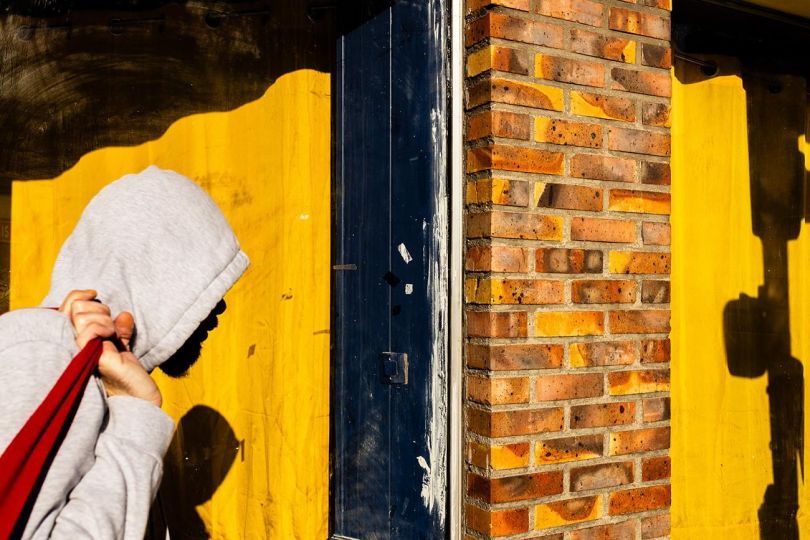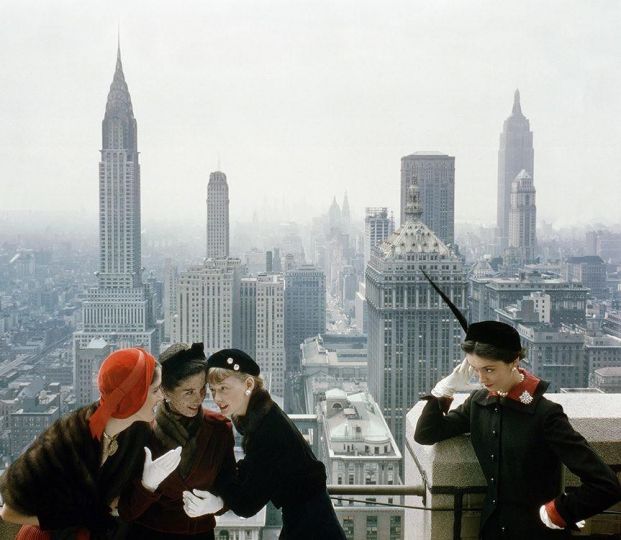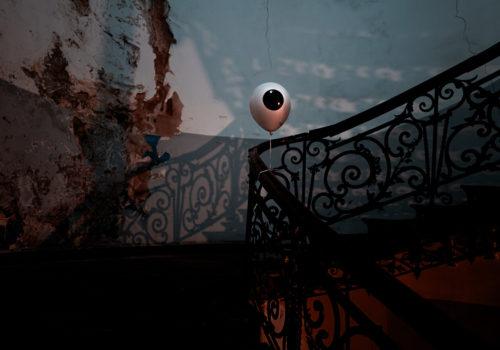I spoke with John Schott for the first time in April 2006, when I interviewed him during the early stages of my research on “New Topographics: Photographs of a Man-Altered Landscape,” the 1975 exhibition (now considered a landmark) that proposed a radical shift in photographic depictions of the built environment. My notes from that conversation reveal Schott’s wide scope of reference: Ed Ruscha, Walker Evans, Susan Sontag, Rudolf Arnheim, Ludwig Wittgenstein, Donald Judd, Jasper Johns. These names were familiar to me, and their significance to Schott became clear as we talked. However, the reference I had to look up—proxemics, the study of spatial distances and human interactions—is the one I’d like to use as an organizational device for this essay.
Proxemics, pioneered by cultural anthropologist Edward T. Hall in the 1960s, is today associated most commonly with the notion of “personal space” and the communicative power of proximity. Hall diagrammed four levels or zones of social distance, from furthest to closest: public (12 to 25 feet), social (4 to 12 feet), personal (1 ½ to 4 feet), and intimate (6 to 18 inches). This scheme would seem to bear little relation to Schott’s unpopulated depictions of the built environment, but according to Hall, the proxemics of personal space influence the organization of space in our homes and cities, the analysis of which is one byproduct of the Route 66 series. More analogically, perhaps Hall’s proxemic zones can also be used to trace Schott’s gradual embrace of an idea. Honing his artistic identity during this road trip of 1973–74, Schott strategically adopted the stance of a cultural anthropologist, assessing both the material and the intellectual environments through which he was traveling. In the course of this journey, he went from a public engagement with photography to an intimate one.
The public engagement began at the University of Michigan in Ann Arbor, where Schott studied photography and art history at the graduate level. Phil Davis (expert in historic processes and meticulous in the darkroom) was a mentor; Nicholas Nixon was a fellow student and Lynne Cohen another emerging artist working on her own in Ann Arbor. Schott’s time at university, the late 1960s and early 1970s, coincided with the so-called Photo Boom, when museums, critics, and the market finally embraced the medium and its many messages. He entered a collective discourse, conducted in institutions and publications, about photography’s history, ontology, and potential; and he absorbed the insights of perceptual psychology in relation to media and communication. Witnessing the paradigm shifts taking place in contemporary art, and, Schott decided to take up the camera himself.
While intrigued by the iconoclastic attitudes toward photography seen in the work of Ed Ruscha and Dan Graham, the artist who riveted Schott—who pushed him from the public space of intellectual/institutional discourse and into Hall’s social space, where interaction is conducted among acquaintances with shared affiliations and agendas—was a generation older and associated with the documentary tradition: Walker Evans. Working in the 1930s at the behest of the Farm Security Administration, Evans rendered American vernacular architecture with a graceful precision that felt bracing to Schott and his generation, especially when compared with the emotive monumentality and grand metaphors of their immediate antecedents Ansel Adams and Minor White—or with the grit and grain of Robert Frank’s street captures. Could photography, he wondered, “just point, but in a very precise, specific way?”
When Schott saw contact prints by Evans on a trip to Chicago in the early 70s, the impact was immediate. He knew the images from reproductions in books, but the quality of the prints astonished him. Struck by their luster and planarity, their “hallucinatory realism,” he woke up to the medium’s materiality and sensibility. He saw the underpinnings of Ruscha’s recent photobooks and Venturi and Scott Brown’s Learning from Las Vegas in the apparent neutrality of Evans’s photographs. He also became convinced of the importance of craftsmanship, so much so that he invested in an 8×10-inch camera. A tool then relegated to the commercial advertising realm, this large-format box camera liberated Schott from the clichés and postures of street photography. And his affinity for Evans put him on common ground—into a social space—with the cohort of artists who would invent the genre of landscape photography that came to be known as New Topographics.
To a large extent, this invention took place along the interstate highways. Funded by grants from the National Endowment for the Arts, many photographers set out on road trips in the tradition exemplified by Evans and Robert Frank. Schott had been making shorter excursions in Michigan, with Lynne Cohen, photographing sites of midwestern sociability such as Elks Clubs. Having gained experience with the large-format camera, but seeking the challenge of an unfamiliar environment, he decided to go west in 1973/74. Nicholas Nixon had just moved from Ann Arbor to Albuquerque to enroll in the MFA program at the University of New Mexico; Schott could visit his friend, meet other members of UNM’s widely admired photography department, and make pictures along the way. Here he would participate in a personal space with like-minded aspiring artists.
Motels were not predetermined as the subject of a photographic series, but emerged as objects of pictorial interest (as well as practical utility) while Schott made his way across the country. Given the mythology of Route 66—a road so often traveled and photographed, just as Bobby Troup’s catchy 1946 song has been so often covered—Schott knew it would be a challenge to come up with something new and different. In his determination to do so, he found inspiration in a range of contemporary artistic movements, from pop to minimalism: an artwork could attain validity on the basis of intentionality, despite humble subject matter or materials. “The difference between a picture taken by the gas meter reader and an artist was conceptual,” remarked Schott, and that was “part of the pleasure.”
The Route 66 photographs are deliberate in their reference to Evans. Like Evans, Schott frequently centered the buildings frontally in the frame, as if drawing their facades in elevation. Occasional oblique angles, the equivalent of an architect’s orthogonal views, are just as carefully constructed. Cumulatively we see a typological survey that had some counterparts in the art world (most notably, Bernd and Hilla Becher) and innumerable counterparts in the commercial realm of real-estate and annual-report photography. With an 8×10 camera on a tripod, he framed each scene and accommodated the southwestern light to represent accurately the varied textures of stucco walls, blacktop lots, and steel Chevrolets. This is a veristic approach, never yielding to abstraction, exaggeration, or offhandedness. For all their studied neutrality, Schott made these photographs in what I am characterizing as intimate space. He engaged with the physical spaces in and around the motels, becoming attuned to how bodies (including his own) behaved in those spaces, and alert to the way motels are at once public, social, personal, and intimate. As Hall had noted in his 1966 book The Hidden Dimension, proxemics was not only observable in the individual but could also be extrapolated to “interrelated observations and theories of man’s use of space as a specialized elaboration of culture.”
Schott’s photographic exploration of the humble Route 66 motels was in fact an exploration of his own goals as an artist. During his time in Ann Arbor he had been attracted, like most bright students, to the irony he saw in contemporary art and to the funkiness of contemporary music, movies, and fashion. But as he got more deeply involved with the photographic medium, he found himself wanting to make more complex, perhaps more sincere, statements in his work. Rather than providing the viewer with an arch message, he wanted to leave more room for interpretation. While Schott established this position pictorially, he also articulated it for Nixon, who was addressing these very issues in his UNM master’s thesis, “Ironic Vision in Twentieth-Century Photography.” The Route 66 photographs, as described by Nixon in his final manuscript, effectively leavened cynicism with humanism. Referring specifically to Western Skies Motel, Albuquerque, Nixon wrote: “While it is a black joke on the American literary theme of the fresh response to newness, there is also present an underlying responsibility to the power of photography and to all real things; hence balance, wonder, luminosity, method, and clarity are present under the same sky as satire, failure, ignorance, and fear—a simultaneous reflection of and statement about human endeavor.”
Another topic that probably came up in Albuquerque was an exhibition currently being planned by William Jenkins, a young curator at George Eastman House in Rochester, New York, in close collaboration with Joe Deal, a photographer who had just left Eastman House to join the MFA program in New Mexico. The exhibition’s focus had evolved from a historical survey of architectural photography to a sampling of contemporary takes on the built environment—the “man-altered landscape,” as explained in the subtitle. Jenkins honed the concept while traveling to visit artists in 1974 and decided to include work by Robert Adams, Lewis Baltz, the Bechers, Deal, Frank Gohlke, Nixon, and Stephen Shore. Schott was the last addition to the checklist, having sent his Route 66 photographs to Jenkins in late April 1975 together with an eight-page letter expressing his mixed feelings about the exhibition’s premise. While he wasn’t necessarily convinced that the participating artists shared common ground, Schott endorsed Jenkins’s attempt to parse the distinction between “things that look alike but may not be alike.” He himself had engaged in it when producing the Route 66 series, deliberately alluding with his compositions and neutrality to commercially motivated images of the same subjects.
More than any of the other artists involved in New Topographics, Schott recognized that the exhibition’s provocative and timely framework had the potential to affect how all their work would be seen thereafter. Although the immediate critical response was minimal, time bore out Schott’s prediction: already in the 1980s New Topographics was entering photographic history as a style or even as a brand. By this time Schott had distanced himself from the intimate photographic practice that had produced the Route 66 motels. Before New Topographics opened in Rochester in December 1975, Schott had received a series of fellowships, relocated to New York, and become a filmmaker, among his early efforts an acclaimed documentary about Robert and Edith Scull, America’s Pop Collector. Since then his concerns as a filmmaker and instructor have focused on narrative and theory, modeling a cross-media practice that has since become widespread. He has continued to deploy deadpan style as a carrier of unruly ideas. His recent return to still photography may well spark another engagement in proxemics: an instinctual and intellectual exploration of his own relationship to the medium, its masters, and its expressive and critical potential. Visualization, in his terms, is a mode of thinking about simplicity and complexity in an integral rather than oppositional way. As Schott himself realized while making the Route 66 series: “My wish is to ‘neutralize’ the world out there not by ‘loving’ it… but by ‘understanding’ it.” That goal, stated in 1975, seems more valid than ever today.
Britt Salvesen
Britt Salvesen is a curator and head of the Wallis Annenberg Photography Department and the Prints and Drawings Department at the Los Angeles County Museum of Art.
John Schott, Route 66 Motels
January 7 – February 10, 2017
Joseph Bellows Gallery
7661 Girard Ave
La Jolla, CA 92037
USA
















